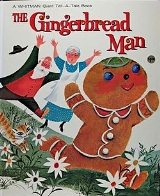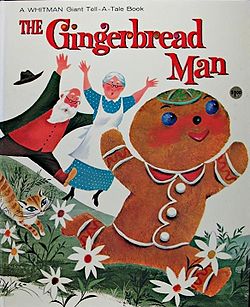
The Gingerbread Man
Encyclopedia

gingerbread Runner is the anthropomorphic protagonist
Protagonist
A protagonist is the main character of a literary, theatrical, cinematic, or musical narrative, around whom the events of the narrative's plot revolve and with whom the audience is intended to most identify...
in a fairy tale
Fairy tale
A fairy tale is a type of short story that typically features such folkloric characters, such as fairies, goblins, elves, trolls, dwarves, giants or gnomes, and usually magic or enchantments. However, only a small number of the stories refer to fairies...
about a cookie's
Gingerbread Man
Gingerbread Man is an album by The Residents, released in 1994. It was their first foray into computer graphics. Original versions of the CD were "enhanced" with animations that followed the music when played on a computer. The animations served as a basis for the costumes of the characters when a...
escape from various pursuers and his eventual demise between the jaws of a fox. The Gingerbread Boy makes his first print appearance in the May 1875 issue of St. Nicholas Magazine
St. Nicholas Magazine
St. Nicholas Magazine was a popular children's magazine, founded by Scribner's in 1873. The first editor was Mary Mapes Dodge, who continued her association with the magazine until her death in 1905. Dodge published work by the country's best writers, including Louisa May Alcott, Francis Hodgson...
in a cumulative tale
Cumulative tale
In a cumulative tale, sometimes also called a chain tale, action or dialogue repeats and builds up in some way as the tale progresses. With only the sparest of plots, these tales often depend upon repetition and rhythm for their effect, and can require a skilled storyteller to negotiate their...
which, like "The Little Red Hen
The Little Red Hen
The Little Red Hen is an old folk tale, most likely of Russian origin. The best known version in the United States is that popularized by Little Golden Books, a series of children's books published for the mass market since the 1940s. The story is applied in teaching children the virtues of the...
", depends on rhythm and repetition for its effect with one event following hard upon another until the climax is reached. A gingerbread boy
Gingerbread man
A gingerbread man is a biscuit or cookie made of gingerbread, usually in the shape of a stylized human, commonly male as the name suggests, although making other shapes, especially seasonal themes and characters, is quite common as well.-History:...
as hero
Hero
A hero , in Greek mythology and folklore, was originally a demigod, their cult being one of the most distinctive features of ancient Greek religion...
is a uniquely American contribution to the tale type. Modern twists on the tale include a gingerbread cowboy
Cowboy
A cowboy is an animal herder who tends cattle on ranches in North America, traditionally on horseback, and often performs a multitude of other ranch-related tasks. The historic American cowboy of the late 19th century arose from the vaquero traditions of northern Mexico and became a figure of...
in a Wild West.
Plot
In the 1875 St. Nicholas tale, a childless old woman bakes a gingerbread man who leaps from her oven and runs away. The woman and her husband give chase but fail to catch him. The gingerbread man then outruns several farm workers and farm animals while taunting them with the phrase:- I've run away from a little old woman,
- A little old man,
- And I can run away from you, I can!
The tale ends with a fox catching and eating the gingerbread man who cries as he's devoured, "I'm quarter gone...I'm half gone...I'm three-quarters gone...I'm all gone!" - a detail often omitted in subsequent versions.
Variations on the original tale do occur. In one of these variations, the fox feigns indifference to the edible man. The cookie then relaxes his guard and the fox snatches and devours him. In some versions, The Gingerbread man halts in his flight at a riverbank, and after accepting the fox's offer as a ferry, he finds himself eaten mid-stream.
In some retellings, The Gingerbread man taunts his pursuers with the famous line:
- Run, run as fast as you can;
- You can't catch me, I'm the Gingerbread Man.
Similar tales, variants, and adaptations
The 1875 St. Nicholas tale is not the first about a runaway food. In SlavicSlavic Europe
Slavic Europe is a region of Europe where Slavic languages are spoken. This area is situated in Central and Eastern Europe and the Balkans, and includes the nations of Belarus, Bosnia and Herzegovina, Bulgaria, Croatia, the Czech Republic, the Republic of Macedonia, Montenegro, Poland, Russia,...
lands, a traditional character known as Kolobok
Kolobok
Kolobok is the main character of an East Slavic national fairy tale with the same name, represented as a small yellow spherical being.The fairy tale is prevalent in Slavic regions in a number of variations. A similar fairy tale with a pancake rolling off has also been recorded in German and Nordic...
is a ball of bread dough who avoids being eaten by various animals. These tales are considered Aarne-Thompson type 2025.
"The Pancake" ("Pannekaken") was collected by Peter Asbjornsen and Jorgen Moe and published in Norske Folkeeventyr (1842-1844), and, ten years later, the German brothers Carl and Theodor Colshorn collected "The Big, Fat Pancake" ("Vom dicken fetten Pfannekuchen") from the Salzdahlum region and published the tale in Märchen und Sagen, no. 57, (1854
1854 in literature
The year 1854 in literature involved some significant new books.-Events:* The Polyglotta Africana, an early classification of African languages based on field work under freed slaves in Freetown, Sierra Leone, is published by Sigismund Wilhelm Koelle....
). In 1894
1894 in literature
The year 1894 in literature involved some significant new books.-Events:*Robert Frost sells his first poem, "My Butterfly", to The New York Independent for fifteen dollars.*Hermann Hesse begins his apprenticeship at a factory in Calw....
, Karl Gander collected "The Runaway Pancake" ("Der fortgelaufene Eierkuchen") from an Ögeln cottager and peddler and published the tale in Niederlausitzer Volkssagen, vornehmlich aus dem Stadt- und Landkreise Guben, no. 319.
Joseph Jacobs
Joseph Jacobs
Joseph Jacobs was a folklorist, literary critic and historian. His works included contributions to the Jewish Encyclopaedia, translations of European works, and critical editions of early English literature...
published "Johnny-Cake" in his English Fairy Tales (1890), basing his tale on a version found in the American Journal of Folk-Lore. Jacobs' johnny-cake rolls rather than runs, and the fox tricks him by pretending to be deaf and unable to hear his taunting verse. In "The Wee Bannock" from More English Fairy Tales (1894), Jacobs records a Scottish tale with a bannock
Bannock (food)
Bannock is a variety of flat quick bread. The word can also be applied to any large, round article baked or cooked from grain. When a round bannock is cut into wedges, the wedges are often called scones. But in Scotland, the words bannock and scone are often used interchangeably.-Scottish:"Bannock"...
as hero. Runaway food tales are classified in the Aarne-Thompson classification system
Aarne-Thompson classification system
The Aarne–Thompson classification system is a system for classifying folktales. First developed by Antti Aarne and published in 1910, it was translated and enlarged by Stith Thompson...
as AT 2025: The Fleeing Pancake.
About 1900 in America, a gingerbread man was generically known as John Dough
John Dough
John Dough was a common name for a gingerbread man at the turn of the 20th century, though the best-remembered John Dough is the character created by L. Frank Baum in his 1906 novel, John Dough and the Cherub; the character also makes a cameo appearance in Baum's The Road to Oz...
. He took the stage as a character who has no qualms about being eaten in A. Baldwin Sloane's musical, The Gingerbread Man (1906). L. Frank Baum
L. Frank Baum
Lyman Frank Baum was an American author of children's books, best known for writing The Wonderful Wizard of Oz...
's John Dough
John Dough
John Dough was a common name for a gingerbread man at the turn of the 20th century, though the best-remembered John Dough is the character created by L. Frank Baum in his 1906 novel, John Dough and the Cherub; the character also makes a cameo appearance in Baum's The Road to Oz...
of John Dough and the Cherub
John Dough and the Cherub
John Dough and the Cherub is a children's fantasy novel written by L. Frank Baum, about a living gingerbread man and his adventures.-The book:...
(1906) and The Road to Oz
The Road to Oz
The Road to Oz: In Which Is Related How Dorothy Gale of Kansas, The Shaggy Man, Button Bright, and Polychrome the Rainbow's Daughter Met on an Enchanted Road and Followed it All the Way to the Marvelous Land of Oz. is the fifth of L. Frank Baum's Land of Oz books...
(1909) is life-sized creation and scared of being eaten, but ultimately sacrifices his hand to save a child's life.
Modern literary runaway food tales include Ruth Sawyer
Ruth Sawyer
Ruth Sawyer was the professional name of Ruth Sawyer Durand , an American children's writer.- Biography :She was raised in New York City with an affluent family...
's Journey Cake, Ho! (1953), a tale about an old couple and their "bound-out boy", Johnny, whose journey-cake is chased by the boy and a variety of animals. Some tales have ethnic settings such as Eric Kimmel's The Runaway Tortilla (2000) about a desert-roving tortilla who avoids donkeys, rattlesnakes, and buckaroos only to be defeated by crafty Sẽnor Coyote; the Hannukah version called The Runaway Latkes (2000) by Leslie Kimmelman; and Ying Chang Compestine's Chinese New Year
Chinese New Year
Chinese New Year – often called Chinese Lunar New Year although it actually is lunisolar – is the most important of the traditional Chinese holidays. It is an all East and South-East-Asia celebration...
tale, The Runaway Rice Cake
Rice cake
A rice cake may be any kind of food item made from rice that has been shaped, condensed, or otherwise combined into a single object. A wide variety of rice cakes exist in many different cultures in which rice is eaten, and are particularly prevalent in Asia. The origin of rice cake seems to be...
(2001). Peter Armour's Stop That Pickle! (2005) is a tale about a runaway deli pickle. His pursuers include a peanut butter and jelly sandwich.
Modern twists on the tale that retain a gingerbread cookie as protagonist include Janet Squires' The Gingerbread Cowboy; The Gingerbread Kid Goes to School (2002) by Joan Holub; and Lisa Campbell's The Gingerbread Girl (2006). In Campbell's tale, The Gingerbread Man's parents mourn his death and then bake a gingerbread daughter. In keeping with the author's disappointment at the original tale's sad ending and The Gingerbread Boy's gullibility, Campbell's Gingerbread Girl outwits the fox that ate her brother and lives happily ever after.
In 1992 Jon Sciezka published The Stinky Cheese Man and Other Fairly Stupid Tales. "The Stinky Cheese Man" is a rendition of "The Gingerbread Man" where the cheese man runs away from everyone fearing they will eat him, when really everyone just wants to get away from his smell.

